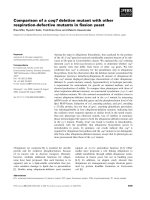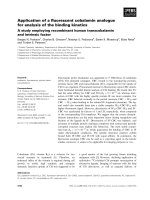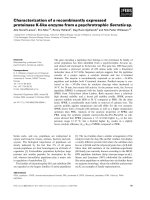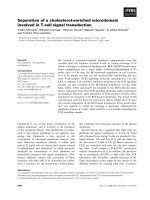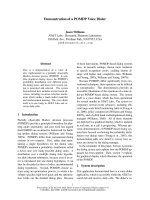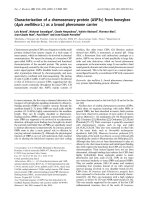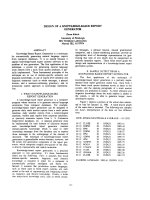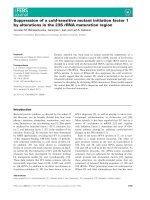Báo cáo khoa học: "LIMITS OF A SENTENCE BASED PROCEDURAL APPROACH FOR ASPECT CHOICE IN GERMAN-RUSSIAN MT" potx
Bạn đang xem bản rút gọn của tài liệu. Xem và tải ngay bản đầy đủ của tài liệu tại đây (407.44 KB, 6 trang )
LIMITS OF A SENTENCE BASED PROCEDURAL APPROACH FOR
ASPECT CHOICE IN GERMAN-RUSSIAN MT
Bianka BUSCHBECK, Renat¢ HENSCHEL, Iris H6SER, Gerda KLIMONOW, Andreas K(ISTNER, Ingrid STARKE
Zentralinstitut ffir Sprachwissenscha~, Berlin
Prenzlauer Promenade 149-152
O-1100 Berlin
ABSTRACT
In this paper we discuss some problems arising in
German-Russian Machine Translation with regard to tense
and aspect. Since the formal category of aspect is missing
in German the information required for generating Rus-
sian aspect forms has to be extracted from different
representation levels. A sentence based procedure for
aspect choice in the MT system VIRTEX is presented
which takes lexieal, morphological and semantic criteria
into account. The limits of this approach are shown. To
overcome these difficulties a human interaction compo-
nent is proposed.
INTRODUCTION
Aspect is considered to bca grammatico-semanticai
category for expressing various temporal references in
relation to the speech act moment. Regardless of the great
number of special meanings that can be expressed by the
perfective or imperfectiv¢ aspect (p.asp./i.asp.), there are
two oppositions representing the systematic or basic
aspectual meanings, namely
+TOTALITY/+LIM/TEDNESS
VerSus -TOTAL1TY/-LIMITEDNESS (see Bondarko 1990).
In this paper we will discuss the transfer of tense and
aspect, a problem which arises immediately in Machine
Translation and differS from language pair to language
pair. This mainly depends on how aspect is expressed in
the particular languages concerned.
It is obvious that aspect in several languages has a
rather heterogeneous formal reflection in the verb system.
Aspect and tense are closely connected with each other.
In English, e.g., the two aspect constructions perfective
and progressive can be seen as realizing the basic contrast
of the action viewed as complete or as incomplete (for
details see van Eynde 1988).
All Slavic languages on the other hand have a well-
formed aspect system where verbs have a perfective and
an imperfectivc aspect derived from the verbal stem by
affixation. The translation of verbal groups from English
into Russian, for example, seems to be possible by for-
mulating rules which assign concrete Russian aspect
forms to several combinations of tense and aspect in
English, e.g.
has been giving
(present perfect continuous)
-> zr~Ba/r (past, imperfective aspect)
has given
(present perfect)
> ~ra~ (past, perfective aspect)
(ef.
Apresjan 1989: 154).
In contrast to the languages mentioned above, aspect
meaning in German, which doubtlessly exists, has no
explicit formal expression. Therefore, aspect information
required for translation into Russian has to be extracted
from different levels of text representation. This is
necessary since without the correct choice of Russian
aspect serious translation errors in the target language
could occur. In our German-Russian MT project VIRTEX
we have approached this problem by constructing a
hierarchic procedure for aspect choice (presented in the
next paragraphy which takes a complex of contextual,
morphological and semantical criteria into account. If the
aspect choice algorithm fails to select one of the two
aspect forms, wider context (beyond the bound-aries of
sentence) or background knowledge must be taken into
consideration. To meet this difficulty VIRTEX is provided
with a system of inquiries. If necessary, human
interaction is entered to make a final decision (in the
sense of Personal MT, see Boitet 1990). A more perfect
solution can only be reached by a more sophisticated text
and knowledge representation including aspectual
characteristics.
- 269 -
A SET OF FORMAL CRITERIA
USED BY VIRTEX
FOR DETERMINING ASPECT AND TENSE
The MT system VIRTEX is made to translate simple
German main clauses into Russian including the decision
of appropriate aspect forms for simple and complex
verbal groups. We distinguish five different types of
criteria all of them operating on the level of a syntactic
surface structure enriched by semantic features:
1. Lexkai Information
German verbs which in every context denote
non-resultative activities are always translated by a
Russian verb in imperfective aspect form, e.g. arbeiten
'to work' - > pa6OTaTT~.
A contrasting class of verbs (siegen 'to win', er-
reichen 'to achieve') which represents achievements (see
Vendler 1967) can be translated in an analogous way into
perfectiv¢ aspect forms unless the context suggests
iterativity.
2. Valency Frames
Some verbs allow different readings concerning their
semantics. These may be distinguished by the occurrence
of certain verbal complements:
(a) Er schrieb an einem Brief.
'He was writing a letter.'
-> Ou Iruca:I nHCbMO. (i.asp.)
(b) Er schrieb einen Brief.
'He was writing/wrote/has written a letter.'
-> Ou rr~tca~/uan~ca~ nuc~uo.
(both aspect forms are possible)
Furthermore, there are German verbs which include
several semcmes differing with regard to their termina-
tive/aterminative usage (cf. Mehlig 1988). Such a verb is,
e. g., the verb sprechen 'to speak'. For translating the
terminative reading of the verb - sprechen mit jmdm. 'to
talk with sb.' - in Russian both aspect forms can be
used:
roBopHT~/IrOroBopHT~
c xeu. Theaterminative
reading of sprechen does not occur in connection with
the preposition mit 'with'. In Russian the imperfective
aspect must be chosen:
Er sprach (vor Studenten) aber Werkstoffe.
'He spoke (to the students) about materials.'
->
Ou
ro~opn~ (*noro~opu~) (~epe~
, CTyAeHTaMH) 0 UaTepua2rax.
Such temporal distinctions of verb readings make it to
some extent possible to choose the appropriate aspect
form already with the help of the dictionary only.
3. Adverbial Semantics
Various types of adverbials may help to arrive at a
decision. In cooecurrence with durative, iterative or
intensity adverbials (e.g. den ganzen Tag lang 'all day
long', h~ufig 'frequently', mehr und mehr 'more and
more'), the imperfective aspect is chosen. If there are
adverbials of punctual meaning (pl~tzlich 'suddenly',
date, time) or of future events (demndchat 'soon') and no
adverbial of the former class, the pcrfective aspect is
preferred. Within the aspect choice algorithm (see fig. 1)
these two classes of adverbs were named ADV-I and
ADV-P.
4. Tense
If none of the aforesaid criteria applies some German
tenses determine the aspect choice:
Past perfect is translated to perfective aspect form,
in the case of the present tense (pracsens futuri ex-
cluded) the imperfective aspect is preferred.
Future perfect is translated into future using the
perfective aspect if there is no indicator of subjunc-
tive meaning which is expressed in Russian by the
preterite form an and insertion of BepoflTnO
'probably'(see the symbol PRT+VEROJ^TNO in fig.l).
5. Aktionsart Type and Additional Conditions
In the case of the remaining tense forms (not listed
in 4.), choice of aspect depends on the verbal semantics.
There are distinctions between durative verbs (warren 'to
wait', diskutieren 'to discuss'), verbs with a resultative
meaning (ertu)hen 'to raise', definieren "to define') or
verbs such as aufz/lhlen 'to enumerate', produzieren 'to
produce', which are characterized by such properties as
limitedness, repeafibility, general faetitive meaning,
named IIM+ITER in
fig. I .
In these cases the existence of
a direct object, its number and definiteness (N4 PLUR,
N4 BET in fig. 1) must be taken into consideration.
For details see figure 1 showing the aspect choice
algorithm for active voice sentences implemented in
VIRTEX. Some of the strict decisions in this algorithm are
preferential ones as will be discussed in the next
paragraph. In the case of the passive voice or of modal
constructions, different sequences of conditions are
- 270 -
I
lexical criteria 9r lexeme-specific valency frame conditions
ASP BY LEXICON I or P
adverbial semantics
ADV I I
I
IMPERATIVE
I
ADV P P
NEG- I
I
P
tense criteria
PAST PERF P
I
PRES I
tense, semantic subclassification and additional conditions
FUT PERF
ADV ANTE
I
P
,
DURATIVE
I, PRT+VEROJATNO
I
P, PRT+VEROJATNO
FUTURE
DURATIVE LIM+ITER N4 DET P
I I I
P I I
DURATIVE
I
P
LIM+ITER
N4 PLUR N4 DET P
I I
P I
RESULT OBJECTS
P
' I
I/P
PERFECT
P
I
I
Symbols: yes
I
no
I
P
choice of the imperfect aspect
choice of the perfective aspect
Figure 1. The VIRTEX aspect choice algorithm for active voice
- 271 -
checked in combination with the operations of passive to
active transformation (if necessary) or structural transfer
for certain modal constructions.
THE ROLE OF CONTEXT
When translating isolated sentences into Russian the
absence of information about how to interpret the verbal
meaning from an aspectual point of view causes major
problems. Often the sentence is too short to fred indica-
tors allowing for a decision between several possible
interpretations (of. Somers 1990) which would lead to
different results of aspect choice. In such cases it is
obvious that by using formal criteria an unambiguous
solution is not possible. In other words: the rigid aspect
choice algorithm implemented in VmTEX at first com-
pelled us to make preferential decisions although we have
been aware of the fact that sometimes another
interpretation of the sentence to be translated would not
be captured.
In the following we shall show with five examples how
certain contexts help us to clarify the intended interpreta-
tion of the given sentence in order to choose the proper
aspect form. Here the term 'context' refers to what is
expressed in the text surrounding the sentence to be
translated or to the user's background knowledge about
the text. As long as this kind of knowledge is not accessi-
ble, it shall be introduced by means of a dialogue compo-
nent.
Current
Process I Result
(1)
Der Student schrieb einen Brief.
(la)
CTyZOHT ~anlcca:~ nHCbUO.
(p.asp:)
'The student wrote/has written a letter.'
(lb)
CTy,£eUT nHcaJI rrHcbuo.
(i.asp.)
'The student was writing a letter.'
In the first version of VmTEX designed without a user
dialogue we preferred the interpretation by:which the
denoted action is assumed to be completed and conse-
quently the perfective aspect is chosen (see: (la)). For
verifying this reading a suitable context criterion could
be, e. g., whether another action follows (sequence of
predicates):
"Der Student schrieb einen Brief. Danach
brachte er ihn zur Post."
'The student wrote a letter.
After that he took it to the post office.'
Variant (lb) is a good translation if the sentence can be
related to a parallel situation or to an action going on
simultaneously: "F.s
war sp~t am Abend. Der Student
schrieb einen Brief."
'It
was late in the evening. The
student was writing a letter.'
To solve this ambiguity by dialogue the user should be
asked whether a continuous process or a completed action
is meant. This may be done by inserting an adverb into
the sentence and asking the user whether the meaning
remains unchanged. The following question should be
asked:
"Ist der Satz so gemeint: 'Der Student schrieb
gerade einen Brief? O/n)"
'Does the sentence mean:
The student was iust writing a letter ? (y/n)'. If the user
says no, reading (lb) is excluded.
Praesens
Futuri /
tlabitual Action
Depending on context, German present tense can be
used to express future events. That holds for every kind
of verb. Indicators like adverbs help in recognizing the
future meaning
("Er kommt morgen. "
'He will come
tomorrow'). Even if the sentence lacks such adverbs, a
future interpretation may be possible but we neglect this
fact for the time being. Only if the German sentence
contains an achievement verb (the achievement verbs
form a subclass of the non-durative ones), the future
interpretation seems to have a higher probability because
this class of verbs cannot be used to denote a currently
ongoing action:
(2)
Er ~st die Aufgaben rechtzeitig.
(2a)
OH pollIHT 3a~a ~rH so-Bpez4~.
(p.
asp.)
'He will solve the tasks in time.'
(2b)
Os peruser aa~a tnf BO-BpeU~.
(i.asp.)
'He solves the tasks in time.'
An indicator for the praesens futuri interpretation
leading to the translation (2a) would be a context like
"Morgen mu~ der Student die Arbeit abgeben. Ich bin
sicher: Er ll~st die Aufgaben rechtzeitig. "
'Tomorrow the
student has to submit the paper. I am sure: he will solve
the tasks in time.' In this case the perfective aspect is
necessary. But it is also possible to assign the sentence an
iterativeJhabitual interpretation leading to sentence (2b).
Then we have in mind rather a certain property than a
concrete action of the person specified in the subject
position. A context suggesting this reading could be a
characterization of the student.
-
272
-
To test whether this reading is meant the user is invited
to compare the original sentence with
"Er l~st die
Aufgaben in der Re~el rechtzeitig."
'As a rule he solves
the tasks in time.' If the insertion is possible without
changing the sentence meaning, the imperfective aspect
of the verb will be chosen, otherwise we assume that the
future interpretation holds, which is expressed by the
per fective aspect.
Type / Token
Another class of verbs (such as
herstellen
'to produce',
exportieren
'to export',
verkaufen
'to sell') causes a type
of ambiguity as shown in (3):
(3)
Der Trabant wurde in der DDR verkaujg.
(3a)
Tpa6a;zT 5~ur rrpozraH B FzTP.
(p.asp.)
'The Trabant car was sold in the GDR.'
(3b)
Tpa6al4T rtpo~aBayIc~ B Fz~P.
(i.asp.)
'The Trabant car was sold in the GDR.'
In a context like
"Au{3erhalb des Landes stieB der
Trabant aufAbsatzschwierigkeiten."
'Abroad the Trabant
car met with sales resistance.' sentence (3) describes a
frequentative process. In another context a single event of
verkaufen
'to sell' could be meant:
"Die Polizei befaBt
sich noch immer mit dera Unfallauto. Es ist jetzt sicher:
Der Trabant wurde in der
DDR
verkaufl. "
'The
police is
still investigating the car damaged in the accident. Now
it is clear: the Trabant car was sold in the GDR.'
You may observe in our example that the aspectual
ambiguity is interrelated with an ambiguity of the
semantic
object: whereas in the first reading i t refers to
a set of objects,
Trabant
is type, ill the second reading
it denotes one concrete individual -
Trabant
is token. The
distinction between type and token requires deeper
semantic analysis which is impossible without contextual
knowledge.
In order to avoid the terms 'type' and 'token' within
the dialogue, two sentences are offered to the user. He
must decide which of them is more suitable to be used as
a paraphrase of the original sentence. With our example,
he must select between
"Dieses Ob/ekt wurde in der
DDR
verkaufl"
'This object was sold in the GDR' and "Di__ge
Objekte wurden in der
DDR
verkaufl"
'The objects were
sold in the GDR'. If the user prefers the first paraphrase,
the Russian perfcctivc aspect will be used, otherwise the
irnperfcctive one.
(4)
Er
(4a)
General Factitive Meaning I Concrete Action
hat Plane ausgearbeitet.
OH pa3pa6aT~Ba:¢ n:mu~.
(i.asp.)
'He has worked out plans.'
(4b)
OH
pazpaSoTag¢ IrZaHH.
(p.asp.)
'He has worked out plans.'
The imperfective meaning (sec (4a)) is inherent in the
source sentence when it is interpreted in the following
way: a person has gained some experience in working out
plans, maybe it was his professional task. Such a
translation underlines the general faetitive meaning which
can be emphasized by using the adverbials
irgendwann
einmal, eine Zet#ang
'some time (during his life)':
"Er
hat irgendwann einmal / eine Zeitlang Plane ausgearbei-
tel." 'Some ti m.¢ he worked out plans.' This is the
preferred reading in the V]RTEX aspect choice algorithm.
Nevertheless, the sentence also can suggest a concrete,
completed action, e. g., if the context refers to the result
of this action as in
"Er hat Plane ausgearbeitet. Sic
liegen zur Ansicht aus."
'He has elaborated plans. They
are open to inspection.' In this case the translation must
use the perfcctive aspect.
To test which of the two readings is the appropriate
one, the system offers a sentence with the inserted
adverbs as mentioned above, and the user is requested to
compare its meaning with that of the sentence to be
translated.
The preference of (4a) to (4b) assumed by VIRT~
would be the converse if the direct object were definite.
Further types of aspectual ambiguity may occur. In
addition, within one aspect form it may become necessary
to resolve temporal ambiguities, e.g.:
Future Perfect / Subjunctive Meaning
(5)
Der Student wird die Prflfung abgelegt haben.
(5a)
CTy,~eNT C~iaCT 3I¢38MeH.
'The student will have passed the exam.'
(Sb)
Cry~eur, Bepo~TuO,
c~a~
3I¢3a~eu.
'The student probably passed the exam.'
Sentences (Sa) and (Sb) exemplify that future perfect in
German does not only express future events but more
ol~en expresses a presumption with regard to events, ac-
tions, etc. which took place in the past. The latter
interpretation could be indicated by adverbs which
- 273
semantically contradict the future interpretation. These
are adverbs of anteriority denoting spans or points of time
in the past such as
gestern
'yesterday',
eben / gerade
'just' or
letztes Jahr
'last year'. In this ease the choice
of the proper aspect form depends on the semantic
subclass of the associated verb. For non-durative verbs
the perfective aspect must be chosen, for durative verbs
- the imperfective one. On the other hand, adverbs of
posteriority underline the future tense interpretation.
Without such adverbials the sentence remains ambiguous.
Adverbs of simultaneity and those deietie adverbs which
can express simultaneity as well as anteriority and
posteriority do not contribute to disambiguating future
perfect sentences because they allow for both interpreta-
tions.
To solve the ambiguity in example (5) the inquiry
might be:
"Nehmen Sic an, da[3 dos bereits erfolgt ist?"
'Do you think that it already happened?'
When formulating the inquiries of the dialogue compo-
nent, we followed the principle that the questions to be
answered by the user should be made as precise and
simple as possible and should not presuppose any special
knowledge in linguistics.
CONCLUSIONS
The above examples show the necessity of taking wider
context into account if the sentences are too short to
make a weUfounded choice of aspect and tense. As a
preliminary solution the integration of inquiries into the
system was proposed. For practical use such inquiries
may be very helpful because they allow us to improve the
translation of isolated sentences and, moreover, of senten-
ces taken from texts. Nevertheless, from the linguistic
point of view there has to be further investigation in the
field of semantics for the automatic generation of the
appropriate aspect forms.
In future we plan to treat aspect and tense by express-
ing them in a deep semantic representation. This forces
us to include wider context beyond sentence boundaries
or extralinguistie knowledge, e.g. style and text typology,
This can be done either in an interactive way as proposed
in this paper or by means of knowledge based MT.
REFERENCES
Apresjan, Juri D. et al. 1989:
Linguistideskoe obespe-
denie sistemy ETAP 2.
Moskva.
Boitet, Christian 1990:
Towards Personal MT: general
design, dialogue structure, potential role of speech.
In:
Proceedings of COLING-90, Helsinki, Vol.3:30-35.
Bondarko, Aleksandr V. 1990:
0 zna~enijach vidov
russkogo glagola
('Aspect Meanings of Russian Verbs').
In: Voprosy jazykoznanija, No. 4:5-24.
Buschbeck, B., R. Henschel, I. Hfser, G. Klimonow,
A. Kfistner, and I. Starke 1990:
VIRTEX - a German-
Russian Translation Experiment.
Proceedings of
COLING-90, Helsinki, Vol.3:321-323.
Mehlig, Hans R. 1988:
Verbaiaspekt undDetermination.
In: Slavistisehe Beitr~ige, Mfinchen, Vol.230:245-296.
Somers, Harold L. 1990:
Current Research in Machine
Translation.
In: The Third International Conference on
Theoretical and Methodological Issues in Machine
Translation of Natural Language, 11-13 June 1990,
University of Texas, Austin.
van Eynde, Frank 1988:
The Analysis of Tense and
Aspect in Eurotra.
In: Proceedings of COLING-88,
Budapest, Vol.2:699-704.
Vendler, Zeno 1967:
Linguistics in Philosophy.
Cornell
University Press, Ithaca, N.Y., 97-121.
- 274 -

